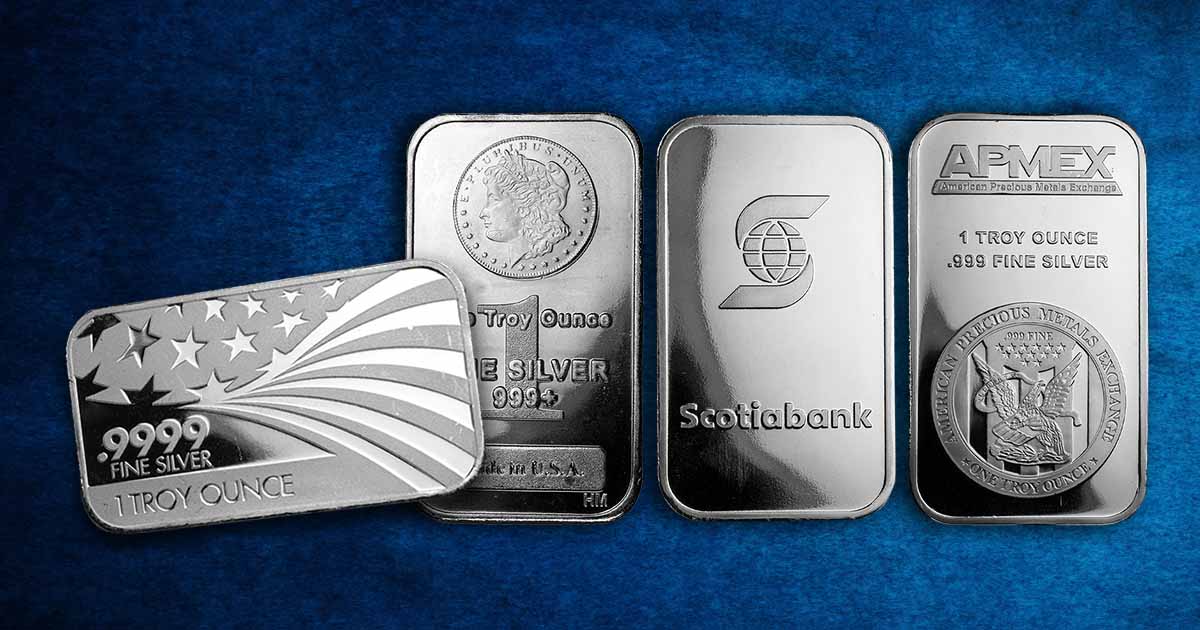
Does your silver bar have what looks like burn marks in two different areas?
There are two potential causes for your silver bar’s discolored spots that look like burns. Your silver bar could be toned, or someone may have artificially tried to tone it with electricity and sulfur. Most collectors who sell coins or bars are honest and have not attempted to alter their coins. But there are instances where a bar or coin has been damaged and toned to conceal damage, like hairline scratches.
To determine which of these two is the cause, you will need to examine the marks. Do they appear gradually, as in do the marks fade into the silver of your bar from the center of the mark?
Or is there a definitive and fine line separating the black marks from the silver? If it is the latter, this is more likely to be an example of artificial toning.
If this is something that appears on multiple silver bars, it might be good to examine your storage containers for small holes that let air in to oxidize the silver. Let’s get a better understanding of toning to appreciate the differences between natural and artificial toning.
What is Toning?
Toning is a term used to characterize the discoloration that forms as a film on the surface of a metal due to chemical reactions between metal and its environment. Oxidation can cause a variety of toning effects, and while many are desirable, others can negatively affect the value of your silver.
Whether a bar or coin has been toned naturally or artificially, it is still the same chemical reaction, even when electricity is used. Artificial toning is a method for speeding up natural toning, although it does not add value in the way that natural toning does.
Natural Toning
Natural toning takes years and even decades. It is a slow process that results in unique coloration and patterns as silver slowly reacts to chemicals like sulfur and oxygen. Several kinds of natural toning occur, and there are many factors to consider in the minting process alone. Each of these factors impacts the way a piece of silver tones, and no two pieces have the same toning.
Artificial Toning
Artificial toning can occur in minutes or seconds, depending on the method employed. It often results in vibrant colors. Many methods exist for artificially toning silver, and an experienced eye can spot the effects of artificial toning or forced oxidation quickly. In the case of your silver bar, if it has been artificially toned, the two marks that look like burns are precisely that. The bar may have been placed in sodium hydroxide with sulfur while an electrical current anodized it.
Is There a Visible Difference Between Natural and Artificial Toning?
Does your silver bar or coin display toning in vibrant, near-neon technicolor? It may have been artificially toned. In terms of presentation, artificial toning often has a blotchy look, with little to no gradient fade between colors.
Natural toning leaves colors that change gradually with a subtle gradient. Toned coins can appear blackened around the rim, with the blackness fading progressively back to the silver color closer to the coin’s center.
If you suspect your coin has been artificially toned but are not certain, consider contacting a local coin shop and getting their input.
Is There a Difference Between Tarnish and Toning?
If it is pretty, then it is toned. If it is not pretty, then it is tarnished. Toning, tarnish, patina, oxidation, and corrosion: These words refer to the same process when describing what happens to precious metals and coins.
While there are examples of undesirable toning, such as when a bar or coin turns black, the value desirable toning imparts boils down to eye appeal and preference. Beauty is in the eye of the beholder, and this is especially true of coins. Another collector might pass on what one collector would pay a premium for.
Investing in Silver Bars
When considering investment options, silver bars offer a tangible and accessible way to diversify your portfolio. While color variations from tarnish or toning might appear on your bars, they do not diminish the intrinsic value of your investment. For some investors, these marks serve as a testament to the authenticity and history of the piece.
Understanding the way silver tones can make you a more informed buyer, especially when considering larger investments. For those looking to make a significant silver investment, 100 oz bars provide a substantial and efficient way to store wealth in silver. Their size and weight make them a preferred choice among serious investors and they generally carry a lower premium than smaller silver products. Explore our wide assortment of 100 oz silver APMEX bars and find the perfect addition to fit your investment strategy.




